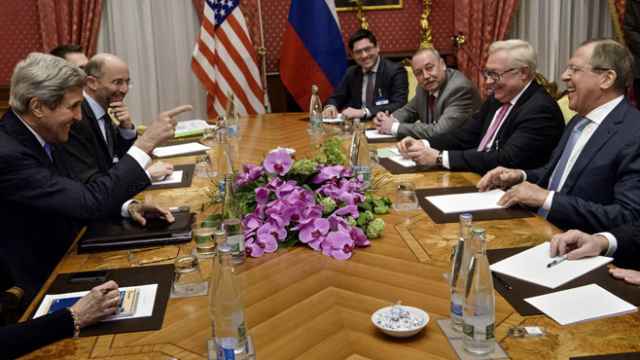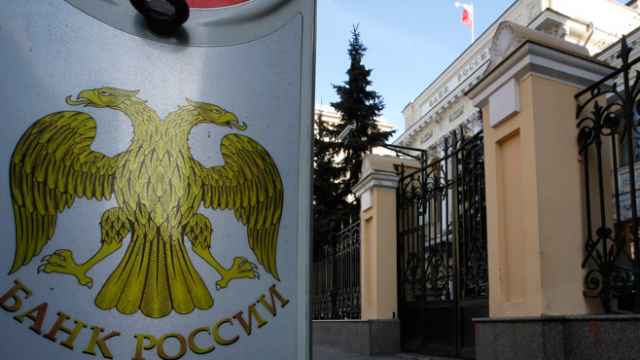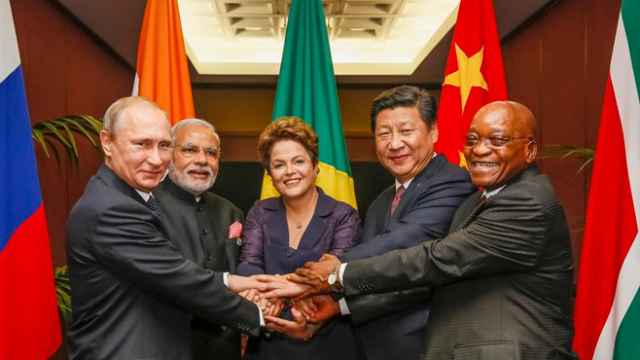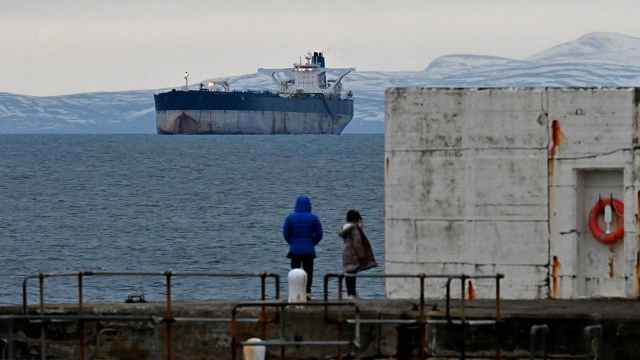The strong rally in the oil price over the past four months has confounded most forecasters. Instead of continuing the late 2014 slide to test the 2009 low of $42 per barrel, the price of Brent came close to $45 on Jan. 13 before starting a steady climb, which brought it close to $68 late last week.
That price rally, which has been replicated in Russia's Urals contract, is a big part of the reason why the ruble has rallied strongly since early February and why there is so much optimism that Russia's economy has weathered the economic crisis relatively unscathed. It is also the main reason why the RDXUSD, the index of Russian equities traded on international bourses, is one of the best in the world so far in 2015 with a gain of 34 percent.
So, has the oil price again helped the country dodge an economic drubbing, or is the rally merely an interruption to a longer lasting downtrend? Most of those who were very confident of their predictions at the start of the year are much less confident today. There is, instead, an almost equally spread range of price predictions from $45 to $90 per barrel by end this year for Brent crude.
The difference between both extremes is whether one believes that the fundamentals of supply, in particular, and demand, to a lesser extent, are changing. Whether the U.S. Fed starts to raise its benchmark interest rate or not is also one of the variables while some of the bulls are also factoring in an expansion of the various conflicts in the Middle East and North Africa.
Let's have a look at the pros and cons for each of the arguments set out by the oil price bulls and bears.
The demand side equation is straightforward; both the bulls and bears expect global oil demand to be higher this year than was the case last year. The International Energy Agency (IEA) agrees with both and has recently raised its total expected demand forecast by 1.1 million barrels per day (mln bpd) to a total expected average of 93.6 mln bpd.
That is better than the incremental growth of 700,000 mln bpd achieved in 2014 and is more consistent with the long-term average growth. A higher average is unlikely, or by very little, given the global economic outlook. A much lower result is also unlikely, as there does not appear to be any potential crisis on the horizon among the big oil-consuming nations.
The main debate concerns the supply side. The traders who helped propel the oil price higher over the past four months cited the reports of rig withdrawals in the U.S. as evidence that output from the shale producers would soon fall. Instead, almost all the rigs have been taken out of speculative sites and not impacted production.
U.S. shale is increasingly a technology improvement story and average producing costs are falling, albeit slowly. The U.S. produced an average of 11.81 mln bpd in 2014, according to IEA data, and this had risen to 12.73 mln bpd by April this year. The IEA does expect a slowing in the second half as new fields come on line more slowly, but still expects a full year average of 12.52 mln bpd. That is hardly the basis to support a bullish oil price scenario.
Elsewhere the optimism that OPEC's major players would yield to internal pressure, also a point often cited by traders, has zero basis in fact. OPEC output is traditionally the balancing factor in the global oil market as non-OPEC producers never willingly cut.
That balancing demand in 2014 averaged 30.3 mln bpd and the IEA estimates that it should be 30.5 mln bpd this year. But in April, the total output from the group was at 31.21 mln bpd with output from Saudi Arabia alone above 10.3 mln bpd. That is nearly one million barrels more from the Kingdom than in the same period last year.
A similarly tough talking position from Saudi Arabia's oil minister at the forthcoming OPEC meeting on June 5, to that heard last December, will put a lot of downward pressure on the price.
Total global output is currently at 95.7 mln bpd, up over 3 mln bpd from April 2014, and that is more than 2 million bpd greater than expected full year demand. Not surprising, therefore, that available storage around the world, in the form of parked oil tankers and onshore tank farms, is getting very full.
Apart from demand and supply, which are the normal long-term price determinants, the medium-term picture is often driven by expectations of a change in direction for the trade value of the U.S. dollar. Almost all oil is traded in the U.S. currency so its value has a significant part to play in the price.
This year currency traders are listening to the Fed and trying to figure out when it may start to raise its benchmark interest rate. The currently still-unclear picture is the reason why the U.S. dollar weakened in recent weeks and why the price of Brent pushed up toward $68 per barrel.
If the U.S. economy strengthens over the summer then the Fed will almost certainly make its first interest rate rise in many years during the autumn. That will boost the dollar and hurt the oil price. That has always been the formula.
Speculative trading has also played a part in this year's rally as hedge funds and other traders built up a record volume of long oil positions at the start of the year. Whether in anticipation of, or the cause of, all the bullish talk of U.S. shale and/or OPEC cuts or as a straight trade on a longer U.S. Fed rate decision? Either way, such a large buildup was certainly a price driver and is now a dangerous overhang.
The one oil price ingredient that neither economists nor oil traders can predict is the course of the various wars across the Middle East and North Africa. For now it seems that all are safely contained away from the oil transport routes and oil facilities but the continuing threats certainly justify some measure of risk premium in the price. Dangerous as it is, the current situation hardly warrants more than a $5 p/bbl risk premium unless any of the conflicts put oil flows directly in harm's way.
The return of Iranian oil is also something which die-hard bulls tend to dismiss as either too vague or too long term. The facts suggest otherwise. Iran is currently producing approximately 2.8 mln bpd whereas just before the last round of sanctions that was at least 1 million barrels higher.
One has only to look at the number of investment forums taking place or planned about the opening of Iran post sanctions to understand that a relatively quick return of those 1 million barrels is neither vague, nor will it take too long.
By now you can see that my preference is quite clearly biased on the bearish rather than the bullish side of the argument. But I also agree with those who assume that a price collapse to $40 or lower, as widely talked about late last year, is most improbable.
Instead a drift back to either side of $50 p/bbl — taking the ruble and the equity market down with it — through the summer seems the more likely course. Even the bears were bitten badly enough in the first quarter not to risk taking a bigger bet than that again.
Chris Weafer is a senior partner with Macro Advisory, a consultancy advising macro hedge funds and foreign companies looking at investment opportunities in Russia.
A Message from The Moscow Times:
Dear readers,
We are facing unprecedented challenges. Russia's Prosecutor General's Office has designated The Moscow Times as an "undesirable" organization, criminalizing our work and putting our staff at risk of prosecution. This follows our earlier unjust labeling as a "foreign agent."
These actions are direct attempts to silence independent journalism in Russia. The authorities claim our work "discredits the decisions of the Russian leadership." We see things differently: we strive to provide accurate, unbiased reporting on Russia.
We, the journalists of The Moscow Times, refuse to be silenced. But to continue our work, we need your help.
Your support, no matter how small, makes a world of difference. If you can, please support us monthly starting from just $2. It's quick to set up, and every contribution makes a significant impact.
By supporting The Moscow Times, you're defending open, independent journalism in the face of repression. Thank you for standing with us.
Remind me later.








